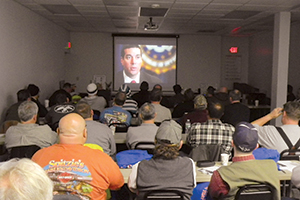Ohio to Require Prospective Truck Drivers to Be Trained to Combat Human Trafficking

Ohio is about to become the first state to require prospective truckers in driving schools and community college courses to be trained for the warning signs of human trafficking under the auspices of Truckers Against Trafficking and the Ohio State Department of Public Safety.
“What we’re doing is another piece towards the goal, which is driving human trafficking out of Ohio, because it’s going to be too dangerous for the bad guys to work here,” said Capt. Mike Crispen, who arranged for new Ohio truckers to receive a wallet card from TAT and is the Ohio State Highway Patrol’s point person on human trafficking.
The National Association of Publicly Funded Truck Driving Schools is a Truckers Against Trafficking partner.
The group “applauds Ohio DPS and TAT for teaming up to educate our drivers of tomorrow,” Executive Director Martin Garsee said.
The Commercial Vehicle Training Association, which oversees the for-profit training schools, also is on board.
“We are happy to help empower future commercial drivers to help authorities spot and deter human trafficking,” said Aimee Napier, president of Napier Truck Driver Training in Hamilton, Ohio. “We are always focused on providing the best all-around training to the next generation of commercial truck drivers, and this video will enhance that training.”
In February, Crispen will begin a collaborative awareness program with his colleagues from Indiana and Michigan.
Since 2009, according to TAT, 1,252 truckers nationwide have called its hotline, leading to 400 potential criminal cases with 692 victims, 234 of whom were minors.
“We knew that truckers could make a huge difference in the fight against human trafficking,” TAT founder and Executive Director Kendis Paris said. She cited a January call by Florida trucker Kevin Kimmel that led to the arrest and sentencing of an Iowa couple to 40 and nearly 42 years, respectively, to prison for sexually related crimes against a 20-year-old woman. “To see everyone in the industry, from corporate executives to mid-management to the truckers themselves, understand the issue and be so moved to take action is extremely gratifying.”
All but four state trucking associations partner with TAT.
“Without question, the Ohio Trucking Association is supportive of anything we can do to combat human trafficking,” OTA President Tom Balzer said. “The driving community is really the first line of defense that we have against this activity. I think we can make a difference by doing this training for people that are already in class.”
The Iowa Motor Truck Association sponsors informational sessions across the state to educate drivers about human trafficking, CEO Brenda Neville said.
More than 170,000 truckers have registered with TAT, and several equipment manufacturers also have partnered with the group.
Before he met Paris at an event in 2012, Scott Perry, vice president of supply management for Ryder Fleet Management Solutions, had “the perspective of most veterans of the industry, that it was a victimless crime.”
But Paris converted Perry with her presentation.
“The mortality rate of those children forced into that lifestyle, if you can call it that, was very eye-opening,” Perry said. “The traffickers are not only targeting children for prostitution, they’re specifically targeting our industry with regard to our drivers, trying to approach them where they’re taking their breaks to take advantage of them.
“We utilize some of the relationships we have in the marketplace to try to advance what Kendis is doing,” he said. “It takes a collective effort across fleets and with different stakeholders to really make an impact and raise the awareness to the level we thought it needed to be raised to.”
Every Ryder employee goes through TAT training, a total that’s nearing 25,000.
Paris hopes that Ryder and Ohio will be trendsetters in combating human trafficking.
“This has become so much bigger than we ever fully realized,” Paris said. “If you see a crime in progress, call 911, but please also call the hot-line. We need to know where the hot spots are. If you call the hotline, you’ll reach a trained specialist to help you ascertain if what you’re looking at really is sex trafficking. You won’t get that if you call 911 or the local sheriff’s office.”

